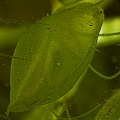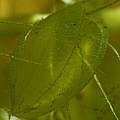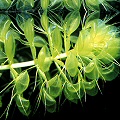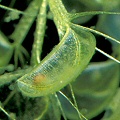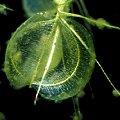Q: Aldrovanda: prey capture in detail
A: Are you interested in exactly how Aldrovanda captures and
digests its prey? You should be, for it is a marvel of evolution!
Recall that each leaf ends in a little clam-like trap, very much in form like the snapping leaf of a Venus flytrap
(Dionaea muscipula). Interestingly, each trap is nestled in a little spray of bristles that
extend from
the flattened, nontrapping part of the leaf that the trap emerges from. Exactly what the bristles do is unclear. I agree with those
who think they function to separate the traps from the water film immediately above the plant. However, they might serve to
more or less funnel prey towards the trap. Perhaps they keep out little chunks of irrelevant detritus.
Or they could provide sites for algae to grow, and thus attract creatures that might
feed on the algae. Such a subtle little plant!
Exactly how the trap captures prey is complicated. Just like the traps of a Venus flytrap, the trap lobes of
Aldrovanda contain trigger hairs. But while Dionaea traps contain
only 6-8 trigger hairs, an Aldrovanda trap may have 60-80 little hairs, each only about 0.5-1.5
mm long. Aldrovanda trigger hairs are somewhat unreliable. Stimulating only one might cause the
trap to snap shut, but sometimes many hairs must be brushed repeatedly in order to trigger the leaf.
But when the trap is stimulated, it moves fast. SNAP! The closure
takes about 1/4 to 1/2 second, which is impressive when you reflect upon the fact that the trap lobes must push water
as they close. If no prey is captured, the trap reopens in ten to twenty hours.
Ah, but if prey is trapped, the most horrible things happen.
At first the trap is only sealed along its margins. Sensing the molecular smell of prey, the trap pumps out the fluid it
contains, like a whale straining out seawater after a gulp of krill-rich water. The trap narrows as water is pumped out of
the trap, probably through little ×-shaped glands in the trap. These glands are mostly distributed in the outer regions
of the trap interior, where the trap lobes are only two cells thick and are relatively flexible. This region is called
the membranous zone.
After about thirty minutes of this pumping, a dramatic
change occurs in the trap shape. The membranous zone of one of the lobes buckles inwards, matching the curvature of the
membranous zone of the other lobe. Now the membranous zones of the two
trap lobes are nested against each other like spoons in a cupboard. This creates a tight seal. Darwin noted that tiny creatures
caught in the membranous zone were squeezed so tightly they were almost crushed. In typical fashion, Darwin described this in
enormous detail, and recorded how interesting it was that the little animals would void their faeces. I cannot help think that
the great naturalist himself would do the same if he found himself in such a situation. I know I would!
(In fairness, I think Darwin was looking for chemical clues that might encourage further action by the plant.)
Back to the plant. Although the membranous zones of the trap lobes become tightly nested, the inner part of both trap lobes
maintain their convex shape, apparently because they are three cells thick, and thus less prone to being distorted. This
interior portion of the traps is called the digestion chamber In my
highest-power images of Aldrovanda traps, you can see the boundary between the membranous zone
and the digestion chamber---lit by my flash gear it looks like a shining arc
that follows the curving line of the trap margin, but with
about half the diameter of the whole trap. Enzymes released by the trap dissolve and digest the prey, and a few days to a week later,
the trap reopens and is hungry for more prey.
Page citations: Darwin, C. 1875; Lloyd, F.E. 1942; Lowrie, A. 2013; Rice, B.A. 2006a.
